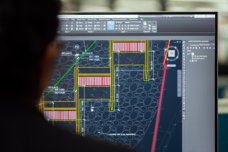What does land administration do?
Land administration is about the relation between people and land or other natural resources. Land relations may cause people to claim a piece of land or a resource as their own. This often leads to the question of whether other people agree with such a claim of ownership and accept it. Land administration aims to provide clarity by finding methods of fairly assessing relations and documenting them in a way that prevents future disagreements.
Which ways are there to establish land relations?
Land administration tries to bridge two worlds – cadastral mapping as applied by land surveyors and land registration as implemented by the legal world. Both are equally important and a cooperative system is a must.
• Cadastral maps are often the oldest maps a country has. As long as there have been governments, these rudimentary maps have been made, primarily to claim certain areas or territories. Another obvious motive for cadastral mapping is being able to tax people for land use.
• Land registration, on the other hand, is much more about describing land relations in legal terms. Unfortunately, the resulting laws are sometimes too strict to handle all forms of land relations.
Are land rights always about ownership?
Land rights can be defined by other relations besides ownership. In today’s world, many countries use their legal system to establish land rights. However, before there were formal written laws, people had relations with land through customary and traditional systems. These earlier relations, which many people in the world still go by, are often ignored by modern legal systems. A similar phenomenon can be observed in rapidly growing urban areas, where people move in without always having the money or time to find legal access to land. They informally settle in what is generally called slums. In these slums, land relations – hence, land rights – exist, but governments rarely recognize them.
What’s the dynamic between land use and land relations?
Land use is often quite diverse. Not one person is the sole user, holder or owner of an area, but a number of people jointly have different complementary relations to it. It could be that one person uses land for grazing his animals while another has the right to pick the fruits from the trees in the same area. Perhaps even a third person can eventually cut down the trees and use the wood. There can also be a time element, e.g. where one group of people uses land for growing crops in the summer, whereas another group grazes their animals during winter.
Geospatial technology can help to clarify and visualize the complexities involved here. However, governments or laws often stand in the way of allowing it. This can be due to fear of change, but vested interests by elites tend to play a part as well.
How do PES schemes influence land relations?
In PES (Payment for Environmental Services) schemes, organizations such as the UN pay people to make sure that forests become greener, store more carbon, or retain water better. However well intended, these schemes can also mean that people need to change the way they use their land and resources. They might no longer be able to do everything they used to do and should be compensated for that. Unfortunately, as land use tends to be simplified to one dominant ‘owner’, the people most impacted by behaviour change are often not the same ones who receive the compensation.
What can remote sensing contribute?
There are 1 to 3 billion people in the world whose land relations are currently not well documented in a system that gives them any protection or security. At the same time, SDG 1.4.2 – one of the indicators of the UN’s Sustainable Development Goals – stipulates that by 2030, all people's land relations must be documented. To achieve this huge task, aerial imagery is needed to determine where the boundaries between people’s interests are. These images can be collected using airplanes, satellites, and nowadays also drones. In short, remote sensing has a major part to play here.
Are there any recent developments in land administration?
In modern urban areas height is a 3D dimension that needs to be taken into account more and more. Proper land administration also requires 3D land information, with 3D city models capturing the complexity of apartment buildings or metro lines running under housing estates. In these situations there are different owners and different land uses. 2D maps will simply not do justice to the complexity involved here, if only when it comes to taxation.
This article is based on an interview with Prof. Jaap Zevenbergeen on the Geo Hero Youtube channel. Click here to see the original video of the interview.






